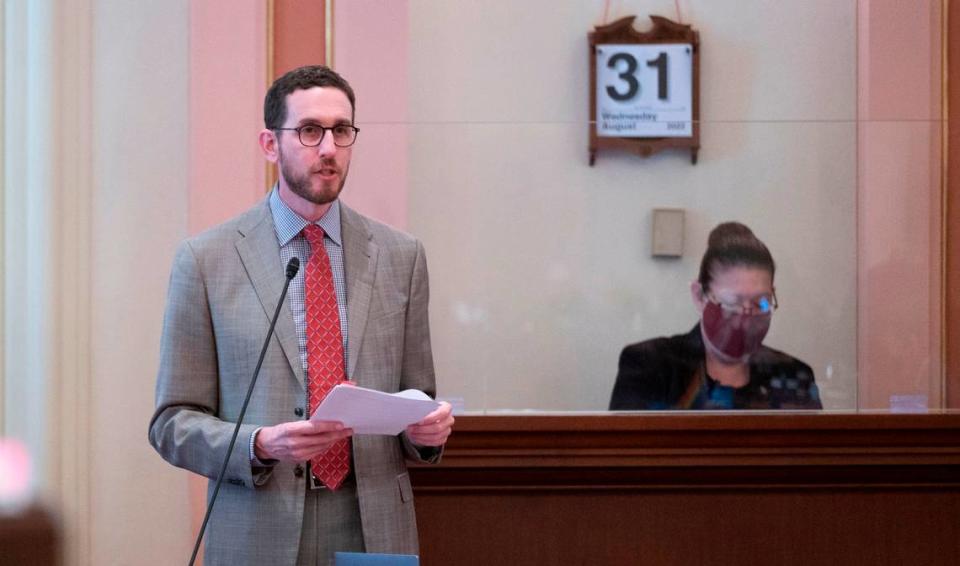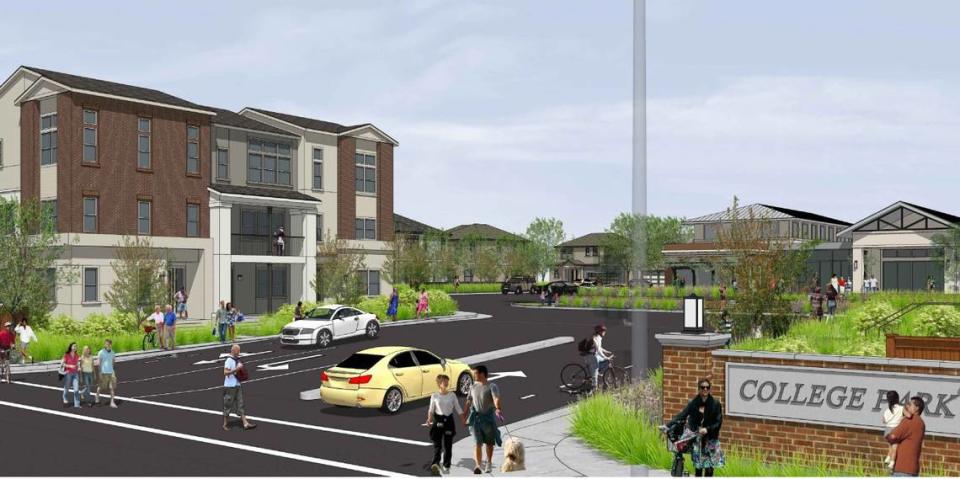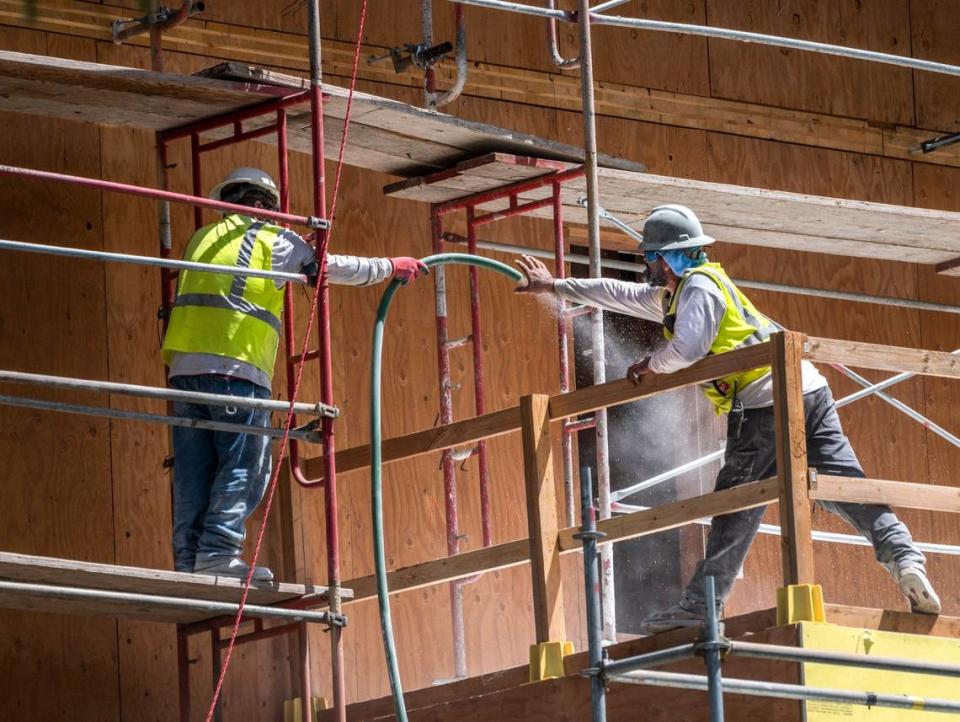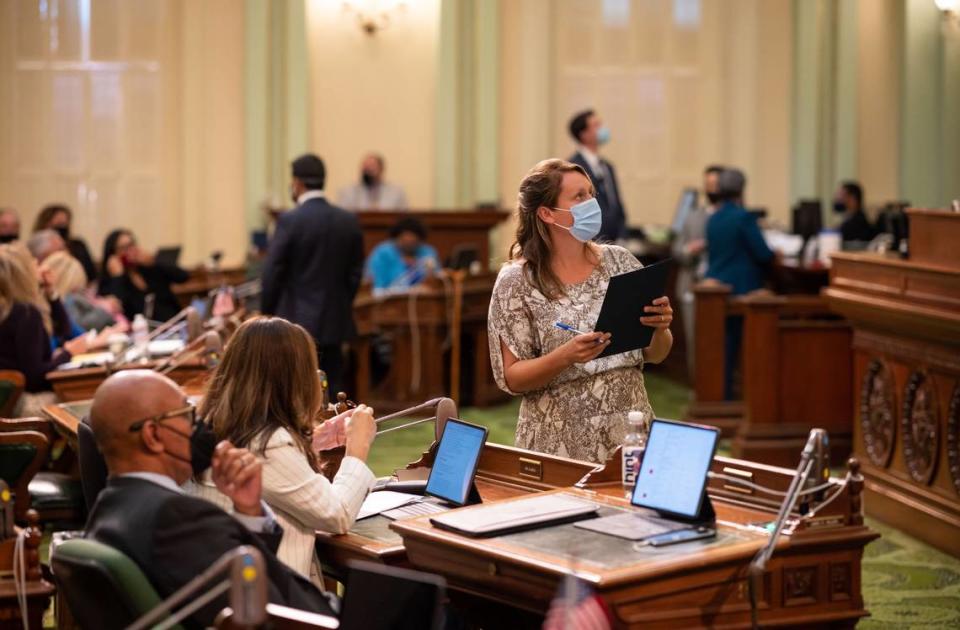Gavin Newsom vowed to fix California environmental law stalling housing. Was the promise empty?
- Oops!Something went wrong.Please try again later.
Gov. Gavin Newsom and top Democrats have repeatedly vowed to reform California’s landmark environmental protection law, which many blame for the state’s inability to build enough housing.
And after years of discussion, Sen. Scott Wiener, D-San Francisco, thought that a recent handful of high-profile housing developments that had been stalled by the California Environmental Quality Act, or CEQA, might provide an opportunity to overhaul the 53-year-old statute.
CEQA was originally envisioned as a way to keep new construction from harming the environment. In practice, it has also generated a half-century of litigation, empowered public efforts to block unpopular developments and tied projects up in lengthy environmental reviews.
Wiener had hopes of “modernizing” CEQA. But before he could introduce his plans, they were shelved.
A document obtained by The Sacramento Bee, and verified by Wiener, shows the senator was preparing to introduce some fairly substantial alterations to CEQA.
Wiener considered allowing public agencies to limit environmental review for certain infill housing — new housing in existing neighborhoods or subdivisions. He also wanted to empower state regulators to limit the scope of the law, according to draft amendments outlined in the documents.
Another element would have declared that the effects of population growth, including noise, congestion and new infrastructure, could not be considered environmentally significant under CEQA and used as grounds for a lawsuit.
“There were some good ideas, but we just decided this wasn’t the year to do it and there was more work to be done,” Wiener said.
Wiener’s abandoned attempt reveals the daunting challenges that stymie reform. Former Gov. Jerry Brown once described it as “the Lord’s work.”
As Wiener said: “In terms of more fundamental reform, the politics are very, very difficult.”

California leaders call for CEQA reform
CEQA, signed into law by Gov. Ronald Reagan in 1970, is designed to protect the natural environment by requiring public agencies to weigh the impacts of development.
Developers’ projects are subject to environmental impact reports, which local leaders review. The reports study possible effects on animal habitats, noise, traffic, air quality and other factors. Builders must consider alternatives to the project and show how they would mitigate adverse outcomes.
It’s a lengthy and expensive process that can turn into years of hearings and litigation, ultimately quashing a project.
If an individual or organization believes a public agency or developer failed to follow all the required steps, they can sue on grounds of a CEQA violation.
Environmentalists, longtime champions of the law, are wary of any changes that could weaken such protections.
But developers and housing advocates contend that CEQA has been weaponized by homeowners and anti-housing NIMBYs — a term that stands for ‘Not in my backyard’ — to legally challenge and delay housing projects they don’t like.

For example, a neighborhood group recently sued the city of Rocklin to block the construction of a mixed-use development with 900 housing units — including a senior living community, single-family homes and apartments — on 108 acres of mostly undeveloped land.
The lawsuit, which is likely to put the College Park project on hold for years, claimed the city failed to consider alternative sites and to adequately analyze negative environmental impacts on aesthetics, air quality and biological resources, among others.
Lawmakers and Newsom have blasted the misuse of the statute and repeatedly vowed to fix it. Yet most attempts at significant reform have faltered.
After a Feb. 24 state court ruling that UC Berkeley violated CEQA by failing to adequately study the potential for added noise and to consider alternative sites for a student and homeless housing project, Newsom said the law needed to change. He affirmed he was “committed to working with lawmakers this year” to make changes to the law.
The governor has not elaborated since then.
When asked what kind of reform proposals Newsom was referring to, the governor’s press office did not answer the question and declined an interview. Instead, spokesman Daniel Lopez provided a statement that read: “This important effort is ongoing and we will provide updates as they become available.”
A few wealthy Berkeley homeowners should not be able to block desperately needed student housing for years and even decades.
CEQA needs to change and we are committed to working with the legislature so California can build more housing. pic.twitter.com/3NC0SsLnMT— Office of the Governor of California (@CAgovernor) February 25, 2023
California environmentalists divided over CEQA reform
Getting major CEQA reform past the finish line would require buy-in from two powerful Democratic Party constituencies: labor and environmentalists.
The law has proven difficult to dismantle due to strong support from influential environmental groups, litigators and some of the state’s most powerful unions. California building and construction labor have been a major reform obstacle, fighting any measure to change CEQA that doesn’t include wage concessions or a requirement to hire union workers.
“CEQA has kind of been the third rail of California politics,” said Jim Moose, a CEQA litigator who supports reforming the law. “Without union support, there’s never been the political will to deal with the fundamental problems of CEQA so what happens is it just gets nibbled at around the edges.”
Amanda Brown-Stevens, executive director of Greenbelt Alliance, is part of an evolving movement within the environmental community that is working with housing advocates to pursue policies that both protect the environment and ease barriers to new housing.
An example is Assembly Bill 68 — referred to as The Housing and Climate Solutions Act — which would streamline approvals for new homes in areas that local governments have identified as a priority for infill housing. The legislation is co-sponsored by California YIMBY and The Nature Conservancy.
As Brown-Stevens sees it, delaying or barring housing projects in urban areas will lead to sprawling development, increasing greenhouse gas emissions and jeopardizing open space. But the environmental justice community is not monolithic, and getting a large coalition on board for major changes to CEQA will be difficult, she said.
“There are people who are rightfully nervous because we’ve seen environmental protections rolled back,” she said. “... But there are many cases where people use environmental lawsuits to delay projects. And pretending that doesn’t happen will not help anything as well.”

Who likes CEQA?
Housing projects delayed and blocked by wealthy Californians and so-called NIMBYs alleging CEQA violations tend to receive the most attention and spark the greatest outrage. But proponents of the law like David Pettit, a senior attorney at the Natural Resources Defense Council, argue that it also serves as an important tool for low-income communities.
In the Central Valley, for example, a number of warehouse projects have been litigated due to concerns about air quality and health impacts on nearby residents.
“The fact that one case comes out the wrong way, doesn’t mean you should throw out the whole system,” Pettit said. “... If CEQA goes away, I think it’s going to hurt low-income and environmental justice communities more than any other, and that would be bad.”
Pettit and other CEQA litigators also contend that the law is not one of the drivers California’s housing crisis. Recent studies by nonprofits Rose Foundation for Communities and the Environment and The Housing Workshop and the Senate Environmental Quality Committee have found that overall litigation rates involving CEQA are low — between about 1-2% of projects face legal challenges.
Ellison Folk, a longtime CEQA litigator and partner with the San Francisco law firm Shute, Mihaly & Weinberger, blames the state’s housing crisis on high construction and land costs and local land use regulations.
“I understand we do have a housing crisis in California but I don’t think exempting projects from CEQA is going to solve that problem,” Folk said. “Fundamentally, I think we need to put a lot more money into building affordable housing.”

Targeted changes to California’s landmark environmental law
In lieu of comprehensive reforms, lawmakers have recently taken a piecemeal approach to alter CEQA.
Measures introduced this legislative session include Assembly Bill 1449, which would completely exempt from CEQA affordable housing developments that meet certain labor and environmental standards. A bill from Assemblywoman Buffy Wicks, D-Oakland, would disallow noise from voices of residents as a significant environmental effect under CEQA for housing projects — a narrow provision crafted to address the UC Berkeley case.
“I can’t believe that you have to write a bill that says human voices can’t be considered as a component, as per CEQA, to stop housing,” Wicks said. “But here we are. And that’s what we have to do.”
Wicks is in favor of comprehensive CEQA reform. But she also believes previous housing bills she and Wiener have authored — which allow certain kinds of housing developments to bypass CEQA in exchange for paying higher salaries and hiring union labor — will make a difference. A measure she authored last year, Assembly Bill 2011, will let builders construct housing in commercially zoned areas with CEQA exemptions as long as they pay workers prevailing wage. Her bill takes effect in July.
“I still think there’s a lot of different debate around it,” Wicks said of CEQA “I think there’s more willingness now by lawmakers and others to say we need reforms, which is good. And I think we’re on the precipice of what those are going to be.”
A different bill from Assemblyman Phil Ting, D-San Francisco, would not directly amend the law. But Assembly Bill 1633 would specify that withholding CEQA clearance for a housing project that is legally entitled to approval is a violation of state law.
Ting authored the bill in response to a San Francisco decision to deny two infill developments downtown.
“We’re in a housing crisis,” Ting said. “I think we want to make it as easy to build housing as possible. And we want to continue to make sure that there is local review, local accountability. But at the same time, we’ve seen local governments all across the state kill housing for any number of different reasons. And it’s really making our state unaffordable.”
